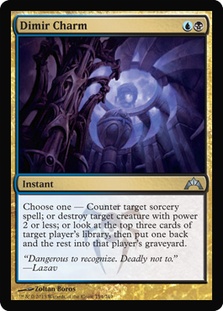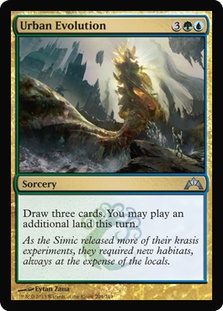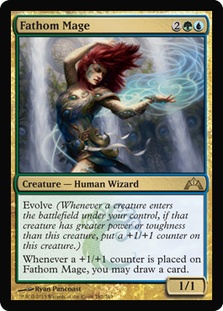Warning: Spoilers!
Gatecrash preview season is in full effect, and not a moment too soon. Return to Ravnica has been pretty sweet, but I think we’re all ready for a fresh Constructed format and some new drafts. Today, I primarily want to look at the mechanic in Gatecrash that I think is most underrated, but first let’s touch on a card that a lot of people have been asking about.
While I’m not sure where it gets its name, Dimir Charm is a card with a lot of challenging to evaluate abilities. To start with, it is actually four abilities (shocker that this one would be the one where that is true…).
1) Envelop
2) Swat
3) Strategic Plannings minus a card
4) Fatigue (somewhat, but with a variety of unusual tactical implications)
It seems like everyone I see ragging on this card neglects to even mention the fourth ability or doesn’t value it highly. First, though, let’s start at the top.
Envelop is the easiest mode to find an analog for, but its power level is deceptive (a theme, it would seem, with these guys). Envelop was a solid tournament card as single U years ago. However, the format was quite different. People played a lot of Mind Sludge, Mutilate, Kirtar’s Wrath, Burning Wish, Grizzly Fate, and more.
What are the most common sorceries of today? Supreme Verdict? Thought Hemorrhage? Let’s keep it real. You and I both know what you really want to counter is Sphinx’s Revelation. Gatecrash may change that, but at the moment, I think Envelop is the weakest mode for Dimir Charm (at least in Standard). It’ll have moments of greatness, but these moments will not always be common.
Next, we come to Swat. Swat was a little weak for even fringe play; however, it also cost three (partially made up for by having cycling). If Swat cost single B and didn’t have cycling, I think it’d have been a tournament staple for sure. That is promising, though the difference between one-cost removal and two-cost removal is pretty big. After all, there is a lot more competition for two-mana removal spells.
Fortunately, there are an awful lot of Swatable creatures these days. It wouldn’t be nearly so impressive if all the targets were Diregraf Ghouls and Arbor Elves. That you can actually hit Huntmasters, Silverblade Paladins, and unevolved creatures is something.
While there are an abundance of little creatures you can hit, such as Snapcaster Mage, Augur of Bolas, and Borderland Ranger, it is the minority of legal targets that you actually want to hit. Many of the best creatures, Thragtusk, Falkenrath Aristocrat, Restoration Angel, Thundermaw Hellkite, and Hellrider, aren’t legal targets.
So far, Envelop and Swat are both solid abilities in the abstract and could definitely become valuable if the format breaks the right way, but neither have me jumping for joy the way Azorius Charm’s top of the deck ability does. What about the third mode?
As I mentioned earlier, I think it is important to differentiate between targeting yourself versus your opponent, as they play radically different. Everyone compares this to a Strategic Plannings without the card draw (which is true for targeting yourself), but what makes you think you are going to want to point that thing in that direction?
Ever use Jace, the Mind Sculptor’s +2 ability? Who do you target more, you or your opponent? Yes, hitting yourself can certainly be good (and is more likely to be good if you Brainstormed last turn), but in general, the more powerful effect is to fate seal your opponent. That’s how Time Walks are born!
The Strategic Plannings ability without the card is a pretty fringe effect for even a single mana. However, the ability to mess up your opponent’s draw in that fashion is often worth two mana (or more). It is the type of effect that you wouldn’t really want on a card by itself but is super powerful 33% of the time… The perfect ability for a Charm!
Seriously, if it were not for this final secret mode, Dimir Charm would actually be fairly lame. However, despite the somewhat dubious positioning of its first couple abilities, the final ability is so good that I think the card will actually be fine. Basically, it is a mediocre removal spell that can be used to Time Walk people going long. Additionally, it happens to have a passable cycling ability if you are desperate and an obscure Counterspell ability.
While you can build around the graveyard-filling element of the card, it is such a weak mode that I wouldn’t want to plan on hitting yourself. What is nice is that you can get a little extra value if you happen to be playing cards like Think Twice or Lingering Souls.
For the most part, I think the card’s utility in Standard is largely a function of how good Swat is. When Swat is good, this card is good. Beyond that, it is probably a small numbers role-player in control decks, unless your deck can really capitalize on the Time Walk aspect of it. In order for that to be true, you basically need to have arrived at a game state where land is a dead draw (which is not always going to come up against every opponent).
Of course, the insidious alternative is to mana screw someone as soon as you see them miss a land drop. Maybe they were going to be removal spells, but if your opponent misses land three and you are hitting yours, an extra turn with your opponent nearly guaranteed to brick can make a big difference.
Basically, LSV’s preview card is a study in wild tactics emerging.
Speaking of Luis Scott-Vargas…
<Luis Scott-Vargas> So, you like two-for-ones like Explore and Divination, right…?
<Patrick Chapin> Yeah…
Now, to be fair, it’s not like the extra land part doesn’t mean anything. In fact, even if you don’t have any in your hand, a 26-land deck generally has an average of an 83% chance of hitting a land off the Urban Evolution itself (and a 59% chance of hitting two out of four to ensure you hit your seventh land drop next turn).
It’s a little strange that blue/red has Thoughtflare, blue/green has Thoughtflare, presumably blue/black will have its version, and then blue/white just gets to have Sphinx’s Revelation. I guess it is what it is…
Basically, Urban Evolution doesn’t scream at me to play it the same way Sphinx’s Revelation does, but there could definitely be some sort of ramp deck that wants to take advantage of it. The key to using it is going to be wanting to ramp to seven mana. If you consistently want to go straight up to seven (ideally playing a Farseek on turn 2, a four-cost spell on turn 3, then Urban Evolution on turn 4), then you can actually take advantage of it enough for it to be worth it.
Drawing extra cards always gets my attention, but what’s really got my eye on the Simic is the evolve mechanic. For instance:
Human. Ooze.
It is easy for people to look at this card and think, “Eh, I guess it’s fine. It is just a 1/1 for one with two minor abilities though, right?”
Minor abilities?!
I’ll grant you the regeneration clause, while nice in the world of Supreme Verdict, properly qualifies as minor. However, evolve is going to take a while to fully understand. It seems really strong. Just walk through the normal play pattern.
Turn 1: Experiment One
Turn 2: Most any aggressive two-drop
Already it’s a 2/2 for one mana with upside. And it’s just getting started. If your deck has a number of 3/3s or better, this guy leads to some seriously aggressive openings. I mean, consider Experiment One, Call of the Conclave, Loxodon Smiter, and three land. That six-card hand has 10/10 worth of creatures in play on turn 3, with an opponent missing nearly half their life.
While the nut draws are excellent, Experiment One is just a very reliable Isamaru with upside. Two-power one-drops are quite strong right now, and green hasn’t actually had any until now. The prospect of turning it into a 3/3 the turn after is super relevant as well.
There is actually a lot of play that goes into optimizing evolve, and there are going to be weird side effects. For instance, Rancor is a bit worse with evolve. You can just Rancor the non-evolve creatures, but every creature you don’t want to put Rancor on does make it worse.
What I find interesting is to think about an opening hand with Experiment One, Call of the Conclave, and Vitu-Ghazi Guildmage. Normally, you’d one-drop into Call into Guildmage to get an extra damage in; but with evolve, you want to play the 2/2 first then the 3/3 to maximize evolve triggers. Where this starts getting tricky is when you replace the Guildmage in the example with a Borderland Ranger. It’s one thing to play your two-drops out of order, but what does it mean to have to wait two turns to play your only two-drop? Or do you just miss an evolve trigger? For six damage, that could easily be worth skipping.
It’s not like Experiment One caps out at 3/3, either. Smiter takes him to four, Thragtusk to five, and so on. He doesn’t grow that out of control big, but we also aren’t talking about a Scute Mob. This card hits for two on turn 2!
Remember to play your Raptor before your Experiment!
Cloudfin Raptor is a little less raw power (at least for Constructed), as a 1/2 flier on the first turn doesn’t take our breaths away. It does evolve more easily, however, and spending just a single mana to build a 2/3 or 3/4 flier is somewhat powerful. A lot of the other evolve creatures may prove stronger in Limited, but I am guessing that the really cheap evolve creatures will have the biggest impact on Constructed. Having passable bodies that get better over time is not winning any awards at three or four mana, but when you have aggressive creatures that can actually rival some of the elite one-drops’ bodies, you are talking about a potential shift in the metagame. Besides, you want to get your evolve creatures out there first so you can start growing them.
Looking at the mechanic as a whole, my intuition is that some players are initially skeptical because the mechanic is not straightforward, has variable power level from game to game, and is not obviously kicker or split cards (aka flashback, buyback, enters the battlefield triggers, cycling, pitch spells, entwine, hybrid, Charms, X spells, multikicker, cantrip, cascade, unleash, undying, persist, replicate, transmute, madness, hellbent, scavenge, retrace, convoke, forecast, rebound, radiance, channel, sweep, epic, Traps, etc.).
It’s important to remember that decks with evolve can’t be all evolve creatures or you won’t get to evolve them very far. This means we are going to need to look for good evolve enablers. What makes a good evolve enabler? Basically a good rate creature with a high power or toughness that fits into our general strategy. It is worth remembering that extra toughness can often be bought on the cheap. It’s not just that Restoration Angel can take the Experiment One up to four, it’s that the sky is the limit with big butts like Silklash Spider!
It is worth mentioning that Zameck Guildmage is worded in such a way so that your creatures come into play with +1/+1 counters already on them. This means they will potentially take the evolution one deeper than they would have been able to. Of course, this doesn’t even factor in that you can keep drawing cards off its second ability, ensuring the evolution never ends.
Giving all of your creatures kicker GU to put a +1/+1 counter on them is not the most impressive ability in the world; however, it does get a lot sexier when you factor in the second ability. Now we’re talking! Spending four mana to draw a card is pretty good, but it’s the ability to keep shrinking evolve creatures that is so enticing.
Evolve creatures give us a free source of +1/+1 counters, with the drawback being that they eventually evolve out of control and we stop getting paid. Zameck Guildmage’s ability harnesses the evolution, and its “cost” (removing counters) turns evolve creatures into a perpetual source of fuel for your combo. While drawing an extra card for four mana (over two payments) is decent, drawing an extra card for two mana is very pushy. This combo is so good that I imagine that ZG will see Standard play and be combined with Experiment One regularly.
What will an evolve deck look like? Obviously, we haven’t seen that many evolve cards yet, and this is probably the sort of thing that is a function of what the most powerful card or two with the keyword does. I do think there are going to be at least two ways to evolve: dedicated and not.
Not being dedicated is easy enough. You just play an evolve creature or two because they have a good rate, maybe a nice synergy or two. For instance, our friend ZG works well with evolve creatures, but he’s also fine on his own. You might just put him in a deck with only two actual evolve creatures and have it work just fine.
U/G Evolving Aggro
4 Experiment One
4 Cloudfin Raptor
4 Zameck Guildmage
4 Strangleroot Geist
4 Wolfir Avenger
4 Deadbridge Goliath
1 Yeva, Nature’s Herald
2 Vorapede
2 Thragtusk
4 Unsummon
3 Simic Charm
4 Cavern of Souls
4 Breeding Pool
4 Hinterland Harbor
3 Simic Guildgate
6 Forest
3 Island
What does Simic Charm do? Who knows, but it’s probably good in here, right?
The more important question is just how sick is Zameck Guildmage with undying? Talk about turning a drawback into upside! Both ZG and Strangleroot Geist are good on their own, but together they form an unstoppable attacker or eternal blocker with the added ability to draw extra cards every time you can arrange for a fight. If we had a good way to sacrifice creatures, the combo might be so good that it is worth considering Young Wolf or Stormbound Geist (or more Vorapede).
An added benefit of undying in an evolve deck is that it triggers your evolve creatures twice. Let’s say you play an Experiment One then Strangleroot Geist. Now, if the Geist dies, he will be big enough to trigger the Experiment One again!
Another fun interaction with evolve is the use of flash creatures. If you lead with a turn 1 Experiment One and a turn 2 Strangleroot Geist, your opponent is in a bad spot turn 3. If they fight the Geist, it comes back stronger and makes the Experiment One big enough to regenerate. If they fight the Experiment, they risk getting blown out by Wolfir Avenger at instant speed. What’s particularly nice is that you can even Wolfir Avenger in response to a Supreme Verdict, moving your Experiment One up to 3/3 so that it can regenerate through (with the Wolf naturally regenerating).
Taking it a step further, Yeva makes every combat involving evolve a nightmare. Maybe this means more Yevas, but its legendary status is a real factor. One of the things I like about the Goliath is that it is going to trigger evolve more often, plus this entire deck is going to be producing lots of big threats. This means opposing Ultimate Prices and the like will be overworked. If they kill your first few threats, Goliath is more likely to live, and even if he doesn’t, he can contribute to yet another threat a little later. I also wonder what incentives to play +1/+1 counters there might be. After all, there is this little number:
Fathom Mage is probably not the right type of thing for Constructed, as it is expensive, fragile, and has no immediate impact on the board. Still, it will be a serious threat in Limited, and it hints at other +1/+1 counter incentives to come. I have no idea what they’d make Constructed quality (other than ZG), but we should definitely have our eyes open for such a card. Scavenge and undying mean there are plenty of easy ways to produce +1/+1 counters in addition to evolve.
While my interest in evolve is at least partially the high power level of some of the cards already revealed (combined with a mechanic that will surely be underestimated by most players initially), I am also a big fan because it rewards us for doing something we want to do anyway. That it can have such variable power depending on the sequencing of our creatures means that there is a lot of room to exploit the mechanic with careful deck design.
What should I cover next week?
What is the best card previewed so far?
See you Monday!
Patrick Chapin
“The Innovator”






